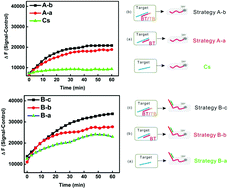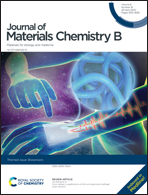Toehold-regulated competitive assembly to accelerate the kinetics of graphene oxide-based biosensors†
Abstract
With effective adsorption and quenching efficiency, graphene oxide (GO) can be utilized for sensing biomolecules such as nucleic acids and proteins. In these assays, the fluorophore-labeled nucleic acid (reporter) is usually adsorbed by GO first, followed by adding the target molecules to bind the reporter, thus restoring the fluorescence signal. However, the kinetics of fluorescence recovery is usually very slow because the target is probably adsorbed by GO and compromises the binding of the target and the reporter. Herein, we proposed a toehold-regulated strand displacement strategy to accelerate the kinetics of GO-based biosensing. In this strategy, the toehold of the duplex mediated a competitive assembly with the aim of eliminating the adsorption of the target by GO, facilitating the binding of the target and the reporter. While the duplex with the toehold of the target-blocker DNA or reporter-blocker DNA was formed, the rigid structure of the duplex weakened the adsorption of the target by GO and enhanced the recognition of the target by the reporter. This strategy achieved up to 2.6-fold enhancement in fluorescence signal restoration for nucleic acid detection, while there was 3.2-fold enhancement in fluorescence signal restoration for thrombin detection. It has also been demonstrated that this strategy can be used for the determination of DNA and thrombin in diluted serum with excellent specificity.

- This article is part of the themed collection: Biosensors


 Please wait while we load your content...
Please wait while we load your content...